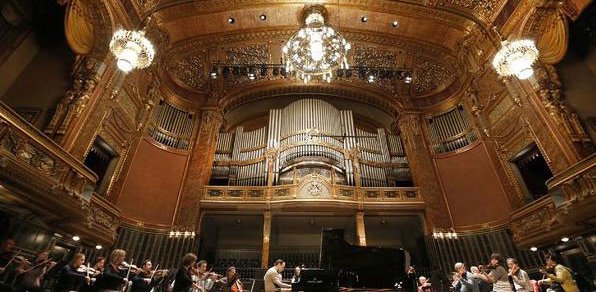But it is not just nostalgia that has made the reopening of the Grand Hall after a four-year renovation a major event. A lot has to do with the hall itself, which dazzles the eye with eclectic architecture and charms the ear with excellent acoustics.
Completed in 1907, the Liszt Academy is one of the world’s few facilities — the Moscow Conservatory is another — conceived to house a city’s primary concert hall and its premiere institution for musical education under one roof. By the time it was built, the composer and pianist Franz Liszt was long gone, but the academy of which he became president in 1875 continued to flourish and required new facilities; its home during the years he was in charge now contains a museum dedicated to him.
That building is on Andrassy Avenue, famous for its spectacularly ornate Neo-Renaissance architecture. Its successor, the current Liszt Academy, which faces Liszt Square, also has Neo-Renaissance traits, particularly its exterior, but the structure, designed by Floris Korb and Kalman Giergl, is essentially Art Nouveau. The hall and foyers feature Apollonian, Dionysian and other images from Greek mythology, as well as Egyptian and Middle Eastern elements. The splendid stained glass windows are by Miksa Roth.
In the restoration, which cost nearly 45 million euros, or $60 million, every effort was made to obtain materials as close to the original as possible, even going back to the successor of the manufacturer where possible. Probably the most obvious change to the hall itself is the restoration of its original color scheme of black and gold, which replaces a coat of neutral brown paint, but in addition two courtyards were enclosed to form a café and a reception and exhibition hall. The European Union has shouldered 90 percent of the renovation expense.
The hall reopened on Oct. 22 — Liszt’s 202nd birthday — with a gala, but a concert on Nov. 10 by the Budapest Festival Orchestra conducted by Gabor Takacs-Nagy was especially worthy of attention, not least because it featured the Russian pianist Mikhail Pletnev.
The soloist was to have been Martha Argerich, a pianist known for her frequent cancellations. In recent years Mr. Pletnev has done her one better by ceasing to schedule concerts at all, at least as a pianist. As a conductor, this enigmatic and idiosyncratic artist has distinguished himself at the helm of the Russian National Orchestra, which he founded in 1990, and he has devoted energy to composition.
But his greatest gifts are as a pianist, and about a year ago he began a selective return to the concert stage. Here he played a C-major concerto by Mozart, not a famous one, but a work Mozart wrote at age 20, No. 8, K. 246. From the elegance and singing tone that characterized Mr. Pletnev’s unhurried statement of the piano’s first theme, however, you sensed that he was determined to elevate the work to a level of greatness.
And he did just that, bringing depth to the slow movement, reveling in the inventiveness of the concluding minuet-rondo and playing cadenzas that were elaborate yet respectful of Mozart’s ideas. He rewarded the audience’s cheers with a dreamy, highly nuanced account of Schubert’s G-flat Impromptu (op. 90, no. 3) as an encore.
The program also included vibrant accounts of Liszt’s symphonic tone poem “Mazeppa” and Mendelssohn’s Symphony No. 5 in C major (“Reformation”), although the hall’s acoustics would make just about any orchestral performance sound vibrant. Whether seated on the main floor or up in the student balcony (performances are essentially free for students), you feel you are smack in the middle of the orchestra because of the enveloping sound.
This is what makes the hall so celebrated as a venue for chamber music and solo recitals, and fortunately the acoustics seem to have come through the renovation unscathed.
Yet the hall is comparatively small — after the renovation there are fewer than 900 seats, in part because of wider spaces between rows.
The Liszt and the Mendelssohn works pressed against the hall’s limits — a big Mahler symphony would be too much, better suited to Budapest’s Palace of Arts concert hall, which opened in 2005.
Still, the acoustics made these excellent performances sound especially exciting. The Mendelssohn, in particular, had memorable moments at both ends of the dynamic spectrum. The composer’s elaborate, Bach-like contrapuntal treatment of the last movement’s Lutheran chorale tune emerged with awe-inspiring vigor, while the strings’ hushed statement of the “Dresden Amen” progression earlier glowed with intensity.
Still to come, thanks to the renovation, is a new incarnation of the academy’s chamber hall, which fell into disuse and is remembered now mainly as a place where performance examinations were held. To be named after Georg Solti, the great Hungarian-born conductor, the 375-seat hall opens in December with a production of “The Magic Flute.” It will surely provide another reason for paying the Liszt Academy a visit.


